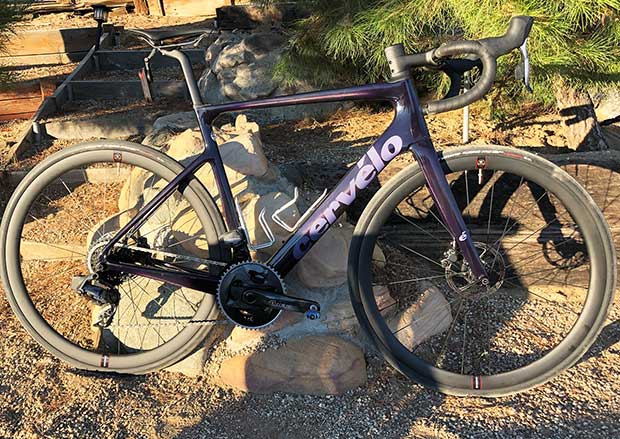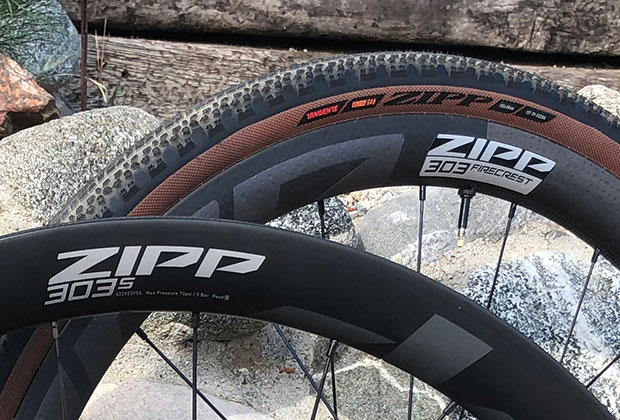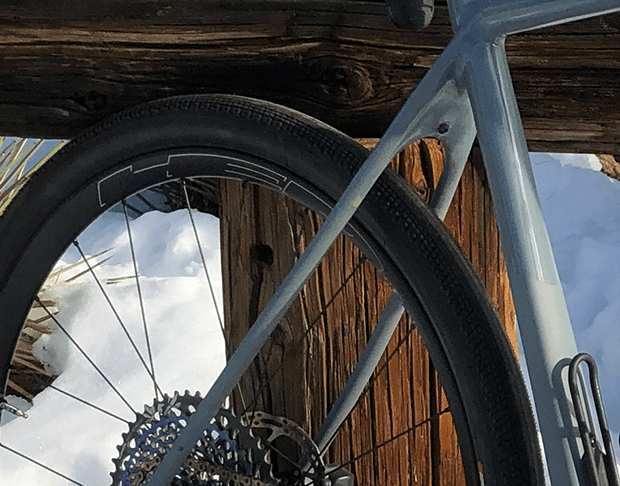Multi-Purpose Bike 2: OBED Boundary
Bikes are expensive and they take up a lot of space. Therefore, a lot of us are doing more with less these days, and brands are accommodating us with bikes that perform a lot of tasks as long as we’re willing to change wheels or tires.
Here’s one example and I’m not reviewing the OBED Boundary today. That’s later. I’m using this bike as a test case and I’ve got another test case coming up this week as well. But you take this OBED as an example, I’ve included 2 pics of this bike. Can you spot the difference? Each build is for a very distinct use case.
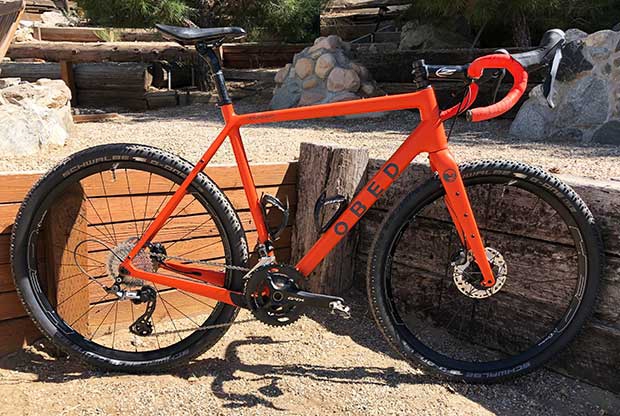
The OBED Boundary above is in my size (L), for somebody 6’2”, which I am, and is for extreme gravel. In fact, I’m going to be setting this up as my go-anywhere bikepacking rig. This bike above is outfitted with 650b (27.5”) HED Emporia (was Eroica) wheels, and Schwalbe 53mm G-One Bites, which is a tire that’s given me really good performance on everything from pavement to stuff for which a dual suspension MTB would be ideal.
Below is the same bike, but this one has Zipp’s new 303 S. This wheel has a Schwalbe G-One Pro mounted on it, in 30mm. This is a rough duty road set up, for bad roads, cobbles, rough chip and seal, rideable dirt. Or, for pavement like glass. It’s an aero road wheel tough enough for gravel, and a road tire tough enough for gravel, but fully functional as an everyday road rider.
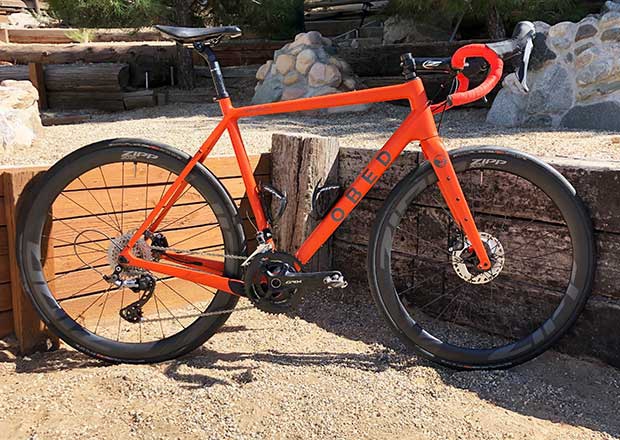
You might wonder whether a bike that can be set up for extreme gravel is a worthy bike for the road. I just reviewed the new Cervelo Caledonia, which is a pure road bike, but it’s use is expansive, from road race out to moderate gravel. But make no mistake: it’s a road bike. Its Pro Tour riders will race the Caledonia during Spring Classics season. Is the OBED with these wheels anything like the Caledonia?
Well, let’s see. The Stack and Reach of the Caledonia in my size is 580mm x 387mm, and the OBED is 590mm x 385mm. Both bikes have a 72° head angle and a 50mm fork offset. The front/center of the Cervelo is 608.5mm and the OBED is 611mm. There are more pronounced differences in chain stay and BB drop, but in fit and steering the bikes are quite similar. Point being, if you wanted one bike that spans the entire breadth of riding, from Caledonia-style all-comer’s pavement to fat-tire gravel, the OBED would give it to you.
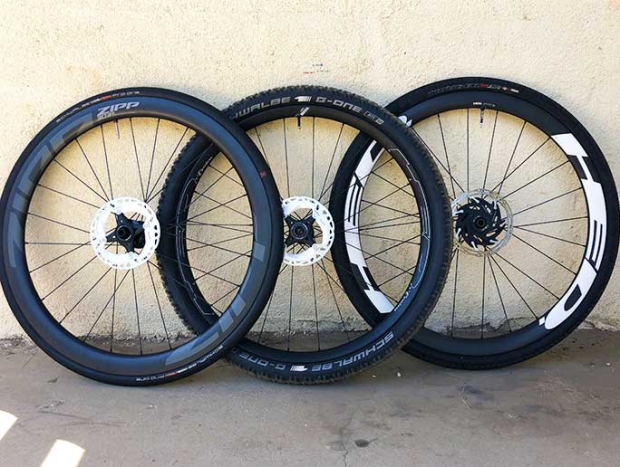
Let’s talk for a minute about how this works, in real life. I chose the wheels I did on purpose, for a specific reason. Wheel radius. Here are 3 wheels above, and 2 are similar and 1 is the outlier. The similar wheels are the HED Emporia and the Zipp 303 S, and how they’re similar is in wheel radius. This means that if the bike designer had in mind the radii of these 2 wheels when coming up with this bike, then bottom bracket height, steering geometry, shoe overlap, is preserved regardless of which wheel you choose. Certainly the Zipp + 30mm road Schwalbes are going to ride faster on pavement. But the bike will feel similar regardless of wheel.
You’ll see 3 marks on the wall in that image above, and a closeup of that image is below. This is the measured height of the inflated tire/wheel. The smallest wheel radius of the 3 is the 700c Zipp 303 S with the Schwalbe Pro One 30mm, and it’s got a wheel/tire radius of 345mm (it's the red line). Next larger is the HED Emporia with Schwalbe G-One Bites in 53mm (green line). Even though the wheel is smaller (the bead diameter of 700c is 622mm, the bead diameter of 650b is 584mm), the distance from the wheel axle to the ground is actually 2mm taller.
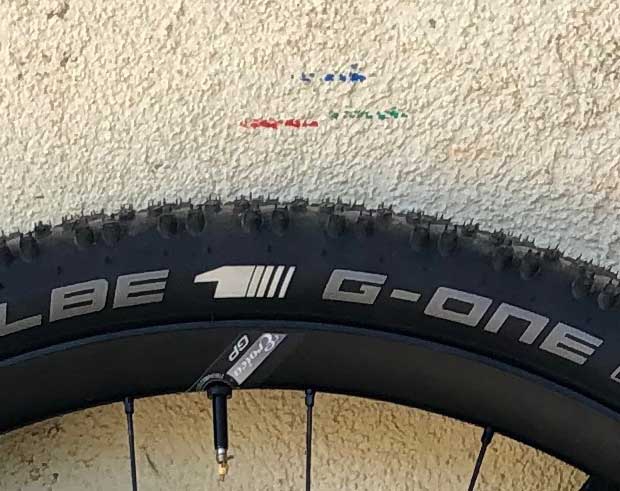
Okay, I just lied. In point of fact the wheel with the fat tire is not taller. Once you weight the bike (sit on it) that fat tire deflects a bit more than the skinny one so, in point of fact, the radius of my two wheels for the OBED are almost identical. This is why the bikes ride with a similar personality.
The outlier (blue line on the wall) is the HED Emporia with the Specialized Trigger Pro 2-Bliss. That set up has a wheel radius of 354mm. This bike is going to ride quite differently, especially when you’re out of the saddle; and when you find yourself in a shoe overlap situation (which is often the case with me in gravel and on steep climbs). If you put a 700c wheel and midrange gravel tire (36mm to 44mm in width) you've made a bike that (in my opinion) handles and rides distinctly differently. Of course if you design the bike from the ground up with this wheel/tire in mind, then fine.
The OBED is sold with either Panaracer Gravel King SK tubeless tires, either 700x43c or 650X48c. You can either buy the bike with either a 700c or 650b wheel, and if I were you I’d choose the 650b (for gravel use). While the option for that 650b wheel is a 48mm tire, as you see I’m up to 53mm and I still have oodles of clearance.
You see the difference in wheel radius as I described it above, and that’s with 700c and a 38mm tire (Trigger Pro). If you buy the OBED in the factory 700c option, that’s a 43mm tire, and I just think this bike rides better with a smaller wheel radius.
I do have 2 bikes with 700c wheels and a 53mm (2.1”) tires, but one’s a hardtail 29er and the other a dual suspension MTB 29er, and those bikes are designed for that wheel radius.
I have more dual-use bikes to show you. I’ve already shown you 2 of them within the week. The OBED is, for me, a fat-tire extreme gravel bike and it’s a crappy-surface road bike. The Cervelo Caledonia is a crappy surface road bike, but it stretches from pure road race up to moderate duty gravel. I have more coming. OPENs, 3Ts and the like.
The point here is that a specific metric ought to be part if your thinking, and that is wheel/tire radius. If you choose wheels of a similar wheel radius, and you choose a bike that’s optimized for that radius, you’ll get a lot of good riding out of that bike across multiple use-cases. Of course this presupposes disc brakes, because we’re swapping around different wheel sizes and the only way one can do that is with disc brakes.


